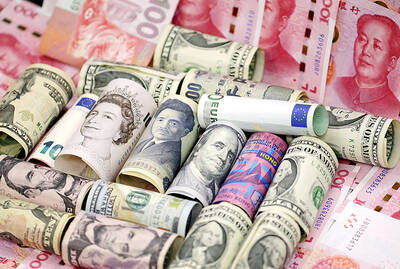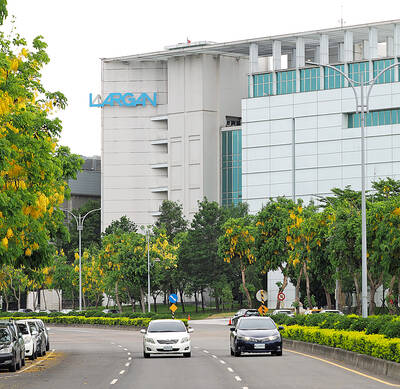The nation’s industrial production last month increased 7.06 percent year-on-year, but slid 1.4 percent from September’s record peak, the Ministry of Economic Affairs said yesterday.
It was the ninth straight month of continuous year-on-year growth for industrial production, as demand for information and communications technology products remained strong, the ministry said, but added that demand might have peaked.
“The demand for COVID-19-related electronics is still robust when you look at it on a year-on-year basis, even though it is down from last month’s record,” Department of Statistics Deputy Director-General Huang Wei-jie (黃偉傑) told a news conference in Taipei.

Photo: CNA
By sector, production of electronic components was up 16.93 percent year-on-year, but down 1.35 percent monthly. In particular, production of integrated circuits rose 23.03 percent annually, but fell 2.98 percent monthly, the ministry said in a report.
Production of LCDs and associated components was up 9.41 percent from a year earlier, although it was down 1.37 percent from the previous month, and that of electronic and optical products increased 6.2 percent annually, but declined 5.76 percent monthly, the report showed.
“Due to strong demand from a new electronic product release, the continued work-from-home demand, and 5G and high-performance computing needs, the electronic components sector reported the 11th month of continuous growth in production,” Huang said. “The flat-panel display sector posted increases both in price and volume, which also boosted production.”
Production of chemical materials last month expanded 8.95 percent year-on-year due to increased demand for epidemic prevention-related products as well as a lower comparison base last year, which saw plummeting oil prices and the US-China trade dispute weighing on production.
On a monthly basis, the sector’s production increased 11.81 percent, the report showed.
Production of base metal products moved up 7.52 percent from a year earlier, which Huang attributed to a lower comparison base for the same reasons, as well as rising international steel prices.
Production was up 3.66 percent from the previous month.
“There is a return to demand from downstream industries such as automotive, mechanical, home appliance and construction,” Huang said of the uptrend in the base metals sector.
Mechanical equipment production fell 0.21 percent year-on-year and 4.54 percent month-on-month, while output of automobiles and auto parts was up 1.05 percent annually and 9.52 percent monthly, the report showed.
Overall, the nation’s industrial production for the first 10 months of this year increased 6.47 percent from the same period last year.
Looking forward, the ministry said that 11.6 percent of local manufacturers surveyed said they think production this month would increase from last month, while 73.8 percent predicted it would hold steady and 14.7 percent said it would decrease.
While COVID-19 remains a pressing concern in Europe and the US, Huang said he does not expect the situation to become as severe as it was earlier this year.
“The difference between the second wave and the first wave of lockdowns is that only non-essentials facilities are subject to mandatory shutdowns,” Huang said. “The impact on industry is hopefully going to be far less.”

Taiwan’s foreign exchange reserves hit a record high at the end of last month, surpassing the US$600 billion mark for the first time, the central bank said yesterday. Last month, the country’s foreign exchange reserves rose US$5.51 billion from a month earlier to reach US$602.94 billion due to an increase in returns from the central bank’s portfolio management, the movement of other foreign currencies in the portfolio against the US dollar and the bank’s efforts to smooth the volatility of the New Taiwan dollar. Department of Foreign Exchange Director-General Eugene Tsai (蔡炯民)said a rate cut cycle launched by the US Federal Reserve

Handset camera lens maker Largan Precision Co (大立光) on Sunday reported a 6.71 percent year-on-year decline in revenue for the third quarter, despite revenue last month hitting the highest level in 11 months. Third-quarter revenue was NT$17.68 billion (US$581.2 million), compared with NT$18.95 billion a year earlier, the company said in a statement. The figure was in line with Yuanta Securities Investment Consulting Co’s (元大投顧) forecast of NT$17.9 billion, but missed the market consensus estimate of NT$18.97 billion. The third-quarter revenue was a 51.44 percent increase from NT$11.67 billion in the second quarter, as the quarter is usually the peak

Nvidia Corp’s major server production partner Hon Hai Precision Industry Co (鴻海精密) reported 10.99 percent year-on-year growth in quarterly sales, signaling healthy demand for artificial intelligence (AI) infrastructure. Revenue totaled NT$2.06 trillion (US$67.72 billion) in the last quarter, in line with analysts’ projections, a company statement said. On a quarterly basis, revenue was up 14.47 percent. Hon Hai’s businesses cover four primary product segments: cloud and networking, smart consumer electronics, computing, and components and other products. Last quarter, “cloud and networking products delivered strong growth, components and other products demonstrated significant growth, while smart consumer electronics and computing products slightly declined,” compared with the

The US government on Wednesday sanctioned more than two dozen companies in China, Turkey and the United Arab Emirates, including offshoots of a US chip firm, accusing the businesses of providing illicit support to Iran’s military or proxies. The US Department of Commerce included two subsidiaries of US-based chip distributor Arrow Electronics Inc (艾睿電子) on its so-called entity list published on the federal register for facilitating purchases by Iran’s proxies of US tech. Arrow spokesman John Hourigan said that the subsidiaries have been operating in full compliance with US export control regulations and his company is discussing with the US Bureau of